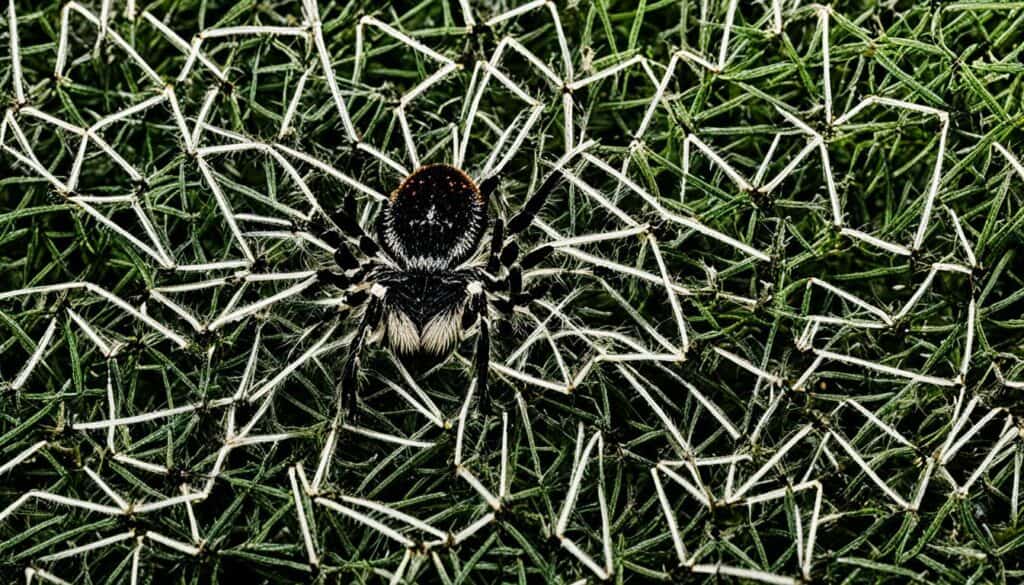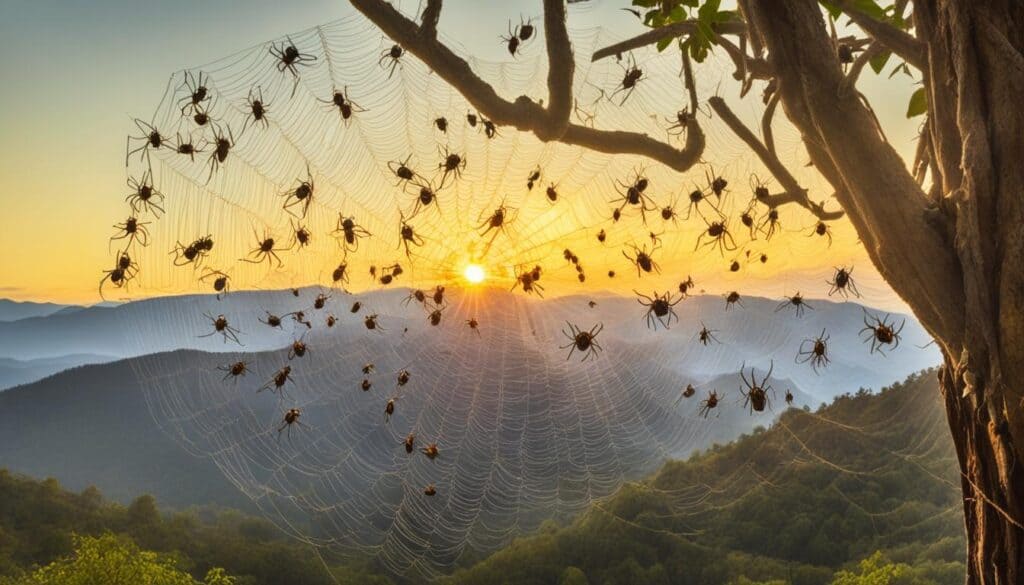Most spiders stay still for a short time when scared, but Joro spiders take it to another level. They can stop moving for over an hour. Originally from East Asia, these spiders arrived in the U.S. around 2013. They’ve quickly grown in number within the Southeastern U.S., especially Georgia.
Even though they look scary and have venom, Joro spiders won’t hurt people or pets. They’ve been wrongly described as dangerous in the news. In truth, their ability to reproduce quickly is why they spread fast. Let’s clear up these misunderstandings and learn the real story of these spiders.
Key Takeaways
- Joro spiders can remain immobile for over an hour when disturbed, unlike most spiders that freeze for less than a minute.
- First documented on the East Coast in 2013, the Joro spider has rapidly spread across Southeastern U.S., especially in Georgia.
- Despite having venom, Joro spiders are harmless to humans and pets due to their inability to break human skin.
- They are not aggressive predators but have a high reproductive potential, leading to their rapid spread.
- Misinformation often exaggerates their threat level; in reality, Joro spiders are timid and unlikely to cause harm.
Joro Spider Overview
I first got to know about Joro spiders at a Georgia barbecue. Talk about a spooky surprise! These spiders likely hitched a ride on ships to America around 2013. Globalization sure brings unexpected visitors.
They have a bold yellow and blue-black look. Talk about spider fashion! By 2015, people saw them in about 25 counties in Georgia. Joro spiders are usually spotted in fall. The females can have a leg span up to 10.16 cm.
Even though they look scary, these spiders are actually shy. If they get scared, they just freeze. Good news for us, their bites are mild, like a bee sting. So, no need to worry too much about them!
Joro spiders are quite the adventurers. They travel long distances on air currents, like using mini-parachutes. It’s their cool way of exploring new places while staying shy.
Originally from East Asia, they now live mainly around Atlanta and up through the Carolinas. Even experts can’t tell if they’ll reach the Northeast soon. It could happen anytime between the next year and ten years.
In conclusion, Joro spiders make for interesting neighbors. They’re not really something to fear. Instead, it’s more fun to learn about and observe these colorful creatures!
How the Joro Spider Reached the East Coast
Did you know that Joro spiders traveled from East Asia to the U.S.? They reached Georgia in 2013. They may have hitched a ride on cargo ships across the Pacific. What an adventurous journey!
But, there’s no need to worry about an invasion. Most Joro spiders stay in parts of the Southeastern U.S., like north Georgia, Tennessee, and the Carolinas. There are millions of them, but they’re not everywhere.
Joro spiders get around by ballooning, but not with actual balloons. Instead, young spiders let the wind carry them by releasing silk strands. It’s an unpredictable adventure. They can move about 10 miles per year on their own.
Researchers are watching them closely. They think Joro spiders might move further north in the next decade. Figuring out their exact path is hard. Spiders are full of surprises.
So, no giant webs in your local park just yet. How these spiders do depends on the weather and where they can find food. Warmer winters and human help mean more spiders might show up.
Joro Spider Behavior and Characteristics
When I first learned about Joro spiders, I thought of a bold spider hunting for food. But these spiders are really shy. Their standout yellow and blue-black colors might catch your eye. However, Joro spiders would rather keep still than battle when disturbed. Their strategy is to freeze, showing they are more peaceful than dangerous.
Now, let’s consider their size. Female Joro spiders have a leg span stretching 3 to 4 inches. In contrast, males are much smaller, only about 0.27 to 0.39 inches big. And do they live well with us? For sure. Joro spiders tend to avoid humans. Their venom is mild, akin to a bee sting, so they’re not a threat to us or our pets.
Joro spiders excel at minding their own business and making homes. They build complex and big webs high above the ground. These spiders show off their skills by crafting nearly perfect circular webs.
In the fall, particularly in September and October, Joro spiders are more visible. This time is critical for them. They mature, mate, lay eggs, and by late November, their life cycle sadly ends. It’s a short yet amazing journey.
Despite their scary appearance, it’s important to know Joro spiders are timid. Researchers from the University of Georgia say they just want to coexist peacefully. So, when you see one, admire it instead of fearing it.
Impact on the Local Ecosystem
Imagine this: you’re in your garden, and suddenly, you spot your first Joro spider four years ago. Today, these colorful spiders have spread across 23 counties in Georgia. What’s shocking is their potential to leave behind hundreds to thousands of eggs. That’s a lot of spiders no one asked for!
The environmental impact of Joro spiders is complex. They eat pests like beetles and flies, which helps your garden. Yet, scientists are unsure about their overall effect on the ecosystem. Are Joro spiders harmless, or do they upset local wildlife? We’re still trying to figure it out.
Some people think Joro spiders might be outcompeting native yellow garden spiders. It’s a twist in the tale of nature. Research is underway to fully understand Joro spiders’ effect on our environment. They’re getting comfortable in both low bushes and tall trees.
Here’s something interesting: Joro spiders arrived in Georgia in 2014. They’ve since traveled to other southern states. But it’s unclear if they can survive in colder places like New York.
Joro spiders travel a lot, but we don’t yet see them as harmful invasive species. They’re like unexpected guests at nature’s party. As we study them more, especially in Georgia, we might learn to see them as allies in our gardens.
Public Health and Safety Concerns
Okay, folks, let’s talk about the big worry—or in this case, spider. Despite scary stories, the Joro spider isn’t a nightmare creature. It’s less painful than a bee sting if it bites. And no, they don’t give you superhero powers!
The Joro spider first appeared in Georgia in 2014. Since then, they’ve been spreading around 50 to 80 miles each year. They could be in southeastern Pennsylvania in 35 years and northwestern Pennsylvania in 60 years. So, no rush to move, Pennsylvania.
These spiders are true survivors. They can brave the cold and lay 400-500 eggs at once. Just imagine taking care of all those spider kids!
Did you know these spiders can balloon? They’re not blowing up like a holiday decoration. Young Joros use silk to catch the wind and float away, much like calling an Uber.
About health concerns, these spiders tend to keep to themselves. If they bite, it might hurt a bit but gets better quickly. Their venom is less dangerous than some pests. Just knowing they’re around helps keep you safe.
Conclusion
Seeing a Joro spider in your backyard can be scary. They’re found often, about one every two yards. Since 2014, they have spread fast in the U.S. They are now in states like Georgia and Tennessee.
What’s causing this invasion? Nature plays a big role. Joro spiders travel through the air, carried by the wind. Humans also help them move, without knowing. Even though it sounds interesting, it can harm our environment.
Our local animals are losing because of these spiders. The Joro spiders eat a lot of insects, hurting our ecosystems. It’s hard to manage them since they live well in many places. They eat many kinds of flying insects.
What should we do then? Understanding them better is our best plan. Let’s learn the real facts about Joro spiders. They are now a part of our environment. With more research, we can learn how to live with them. Knowing more about them can help us get along.




